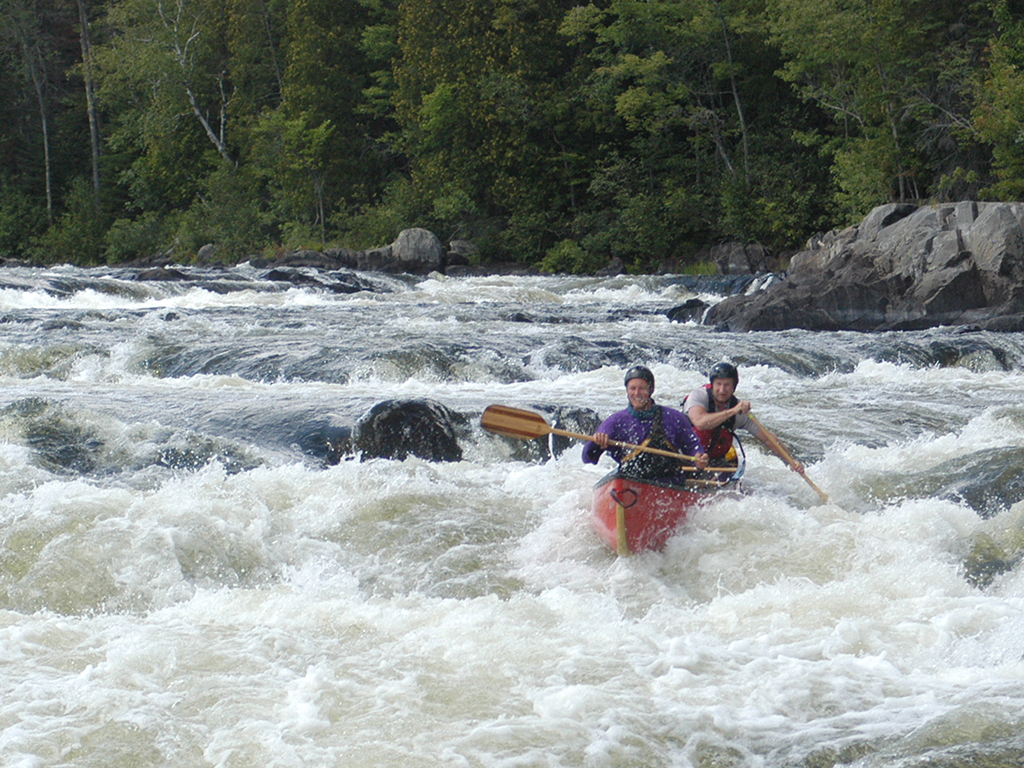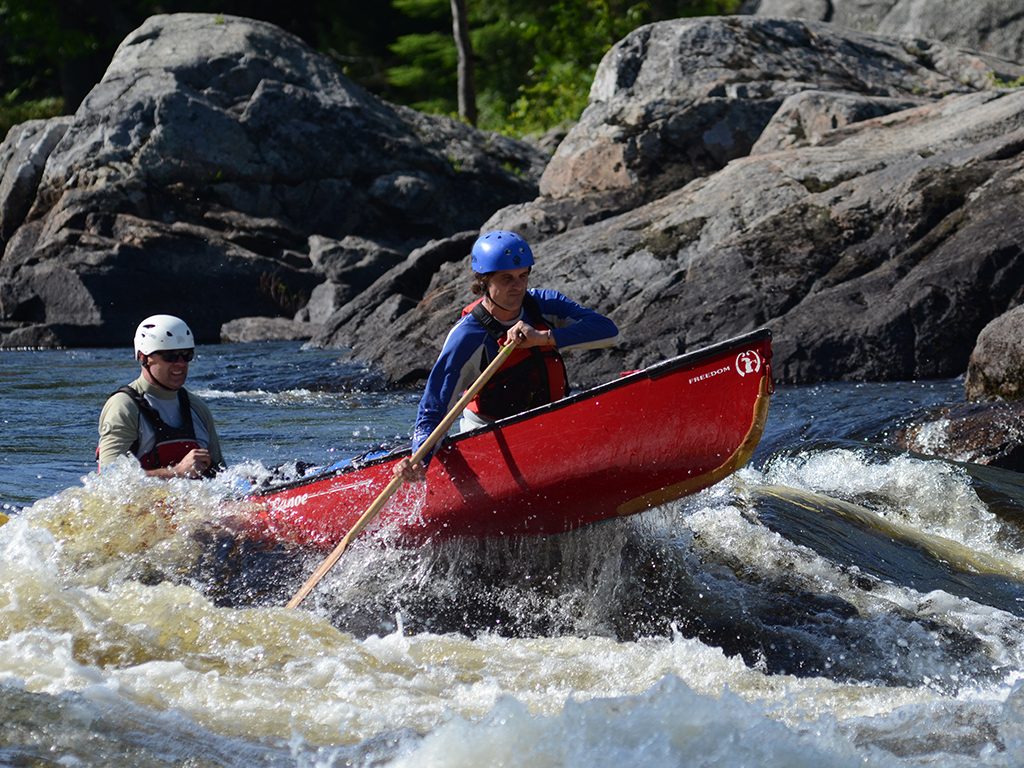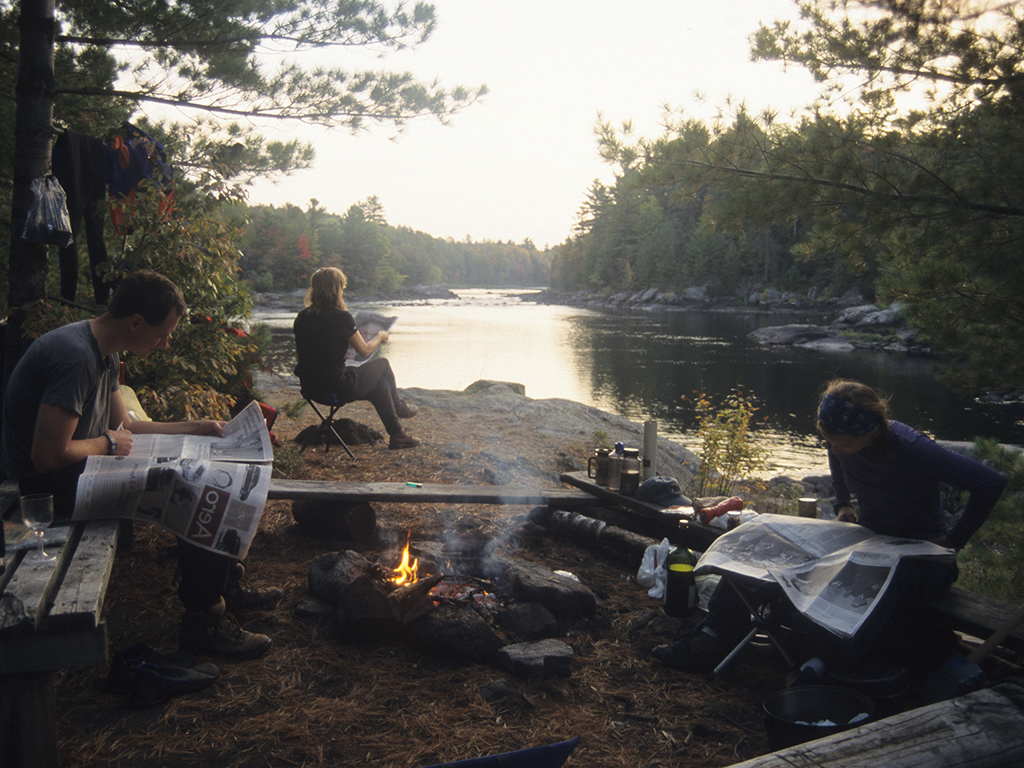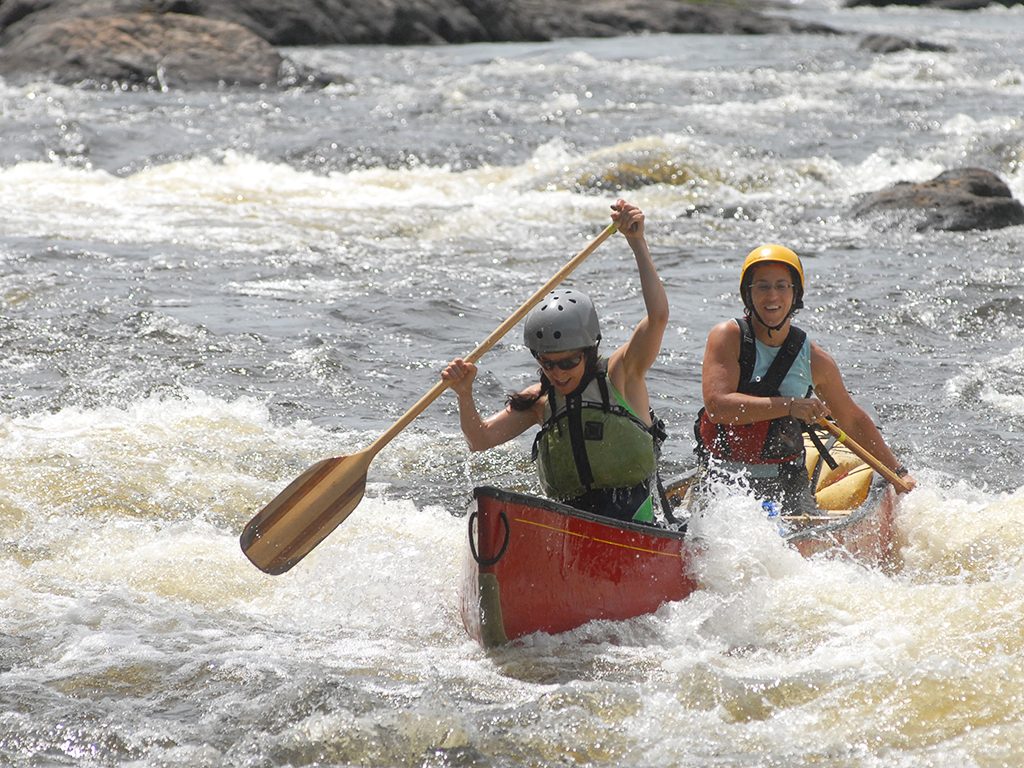“They say you can hear the screams of the dead loggers who drowned there decades ago, if you listen closely enough.”
With those words spoken by our shuttle driver still echoing in my head, my partner launched us into the surging current of Slate Falls on the Madawaska River. My heart pounded in the bow and I strained to get every one of his commands perfect to avoid a similar fate as we negotiated down jagged rock ledges and submarined into the froth.
The stretch is long and steep but, in no time, our water-filled canoe lumbered to safety at the bottom of the falls with my life still intact thanks to my extremely skilled stern paddler and mentor Ken Wood. At that moment, my goal became clear – I wanted the expertise of sterning an open boat down these challenging and dangerous falls – a section of the river that one guidebook advises not to run at all.
A reminder of its unforgiving power can be seen on one of the Slate Falls portage trails. There, etched in granite boulders, are the names of several young men who died driving lumber from the surrounding forests down the river during the late 19th century. A privately-funded stone monument stands not far from the falls to commemorate those brave souls.
If you live in the Ottawa Valley and are into paddling whitewater, chances are you’ve been on the Madawaska River, otherwise known as the “Mad”. And if you haven’t been yet, or want to experience the thrill of running rapids, then this gem is the perfect place to go.
So popular is the river that it attracts paddlers from as far as southern Ontario and whitewater schools such as the Madawaska Kanu Centre rely on the waters for training clients of all skill levels. I have been on the river numerous times and consider it a-home-away-from-home for its fun rapids, gorgeous scenery, exceptional campsites, and ease at getting to the river.The downside of its popularity is that on some long weekends in summer, you may have to wait in line to run a set of rapids. One time, my step-son and I watched in amazement from shore as two macho fathers attempted to show their families how to run a rapid. They paddled ferociously towards a drop with a large rock protruding high above the surface. The canoe hit it dead-on, slid on top, teetered for a moment, and then paddlers and canoe careened to the side and right into the chute.
Despite the many paddlers, there is still quite a lot of wildlife to be seen, such as great blue herons and other waterfowl, beavers, muskrats, and larger mammals. A few years ago while looking for firewood on a portage trail, I nearly stepped on a young black bear that was sleeping in a large hole. On another trip, my wife Marilyn and I watched in shock as a white-tailed deer lost its footing and was swept down a set of rapids. We searched in vain but couldn’t find the hapless animal.
Today, the river is also home to many cottagers, and while it may flow through towns and villages and past farms, the water is still fairly clean – great for swimming on hot days but probably not clean enough to drink untreated. Much of the river is also dam-controlled to generate hydro electricity, meaning the opening and closing of the dams as well as rainfall can dramatically change the character of the rapids.
There are two main whitewater paddling areas on the Madawaska which flows 230 kilometres east from Source Lake in the highlands of Algonquin Park to drain into the Ottawa River at Arnprior. The Upper route is 27 kilometres long and runs from the village of Whitney to Madawaska. Unfortunately, it’s a spring run only since the water level is usually too low to navigate the rapids after May. But, the 16 sets are challenging and a pretty good work-out for experienced paddlers. On this section, the river winds through hillsides of rough-looking wilderness with lots of rock-strewn shorelines until it slows to a quiet winding river. It’s a good weekend trip with some nice campsites on Rapid Lake about three kilometres from the start or further downstream at one of the beautiful chutes or falls. I’ve also run the nearby Opeongo River to add another fun day of whitewater paddling.
The Lower section begins at Palmer Rapids about 15 kilometres southeast of Barry’s Bay and ends 40 kms. at the village of Griffith on Highway 41. Palmer Rapids is called one of Ontario’s best training rapids, offering chutes, boulder gardens, and eddies to develop techniques and is forgiving should the boat capsize. This section of whitewater also has a constant supply of water thanks to Ontario Power Generation which provides daily water releases from a dam upstream for the Madawaska Kanu Centre which is located nearby.
From there, the river continues to wind for a few kilometres through the village of Palmer Rapids, along Highway 515, and beside farmer’s fields with a couple of small rapids thrown in to break up the pace. Next comes a portion 24 kilometres long from Latchford Bridge to Griffith that is the most popular part of the “Mad”.
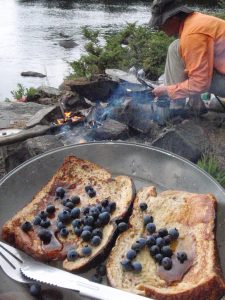
This area was designated as the Lower Madawaska Provincial Park in 1987. There are well-maintained portage trails around all of the rapids in the park, the 36 designated campsites are kept clean, for the most part, and all have fire pits. Some campsites even have deluxe seating around the fire pits thanks to huge cut logs left over from the days of logging.
Not only is the scenery exceptional but you can paddle it any time of year in nearly any water level. Lower water levels can be very interesting since there are a lot more rocks to navigate around. One particular rapid is notorious for causing problems. Paddlers must negotiate down a series of small tongues around an island and avoid a boulder that waits defiantly at the bottom.
On a training run of the Mad in the fall for a trip down the Nahanni River, my two brothers-in-law ran the top part superbly but the bow clipped the rock, flipped their canoe, sending both for a long, cold, and bruising swim. After gathering them up, we quickly made a fire to warm their bodies and spirits. Thankfully, the experience didn’t stop them from doing any more whitewater canoe trips.
A former Madawaska outfitter told me earlier this spring that the same rapid ruined his paddling season last year when he inadvertently wrapped his flatwater canoe around the same rock, which he has since appropriately named “the tombstone.”
A parking area near the top of the park is reachable by logging roads from Griffith or from Quadeville that makes for a great two-day trip though I have talked to people who love the section so much they stay for a week each year.
The first few kilometres is all flatwater with thick forest growing to the banks of the river interspersed with a few areas of marsh land. It’s a good time to practise your paddling strokes since the river soon drops around an island to form the first of the park’s 13 rapids.
Over the next four kilometres lies a beautiful stretch of river called Snake Rapids, featuring small islands, towering white pines, and large flat rocky points that have created some of the best campsites I have stayed at. The river forms eight sets of rapids that are great to practise on – all fairly easy depending on your skill level and the water level, mostly short and easy to swim out of should you flip your boat. Over the years, I have found all sorts of beached gear that fell out of boats – clothes, water bottles, even a video camera. This year, it was a paddle. A walking trail lines the entire length should you care to take a pass on a rapid.
Those people who want to call it a day can access a second parking lot shortly after Snake Rapids. It’s also the last chance to avoid two monsters lurking downstream most portage around – Slate Falls, which I failed to mention earlier, also put a long crack through the center of my canoe, and another very big and technical one called Highland Falls about a kilometre before the take-out at Griffith. This section of river feels more remote with few reminders of civilization, save for a couple of old hunt camps.
There is also a top-notch campsite with a view of the Madawaska braiding between three small islands that is worth getting past Slate Falls. About five kilometres from the take-out, a small rapid marks the beginning of cottage country and the end of a slice of Ottawa Valley paradise.
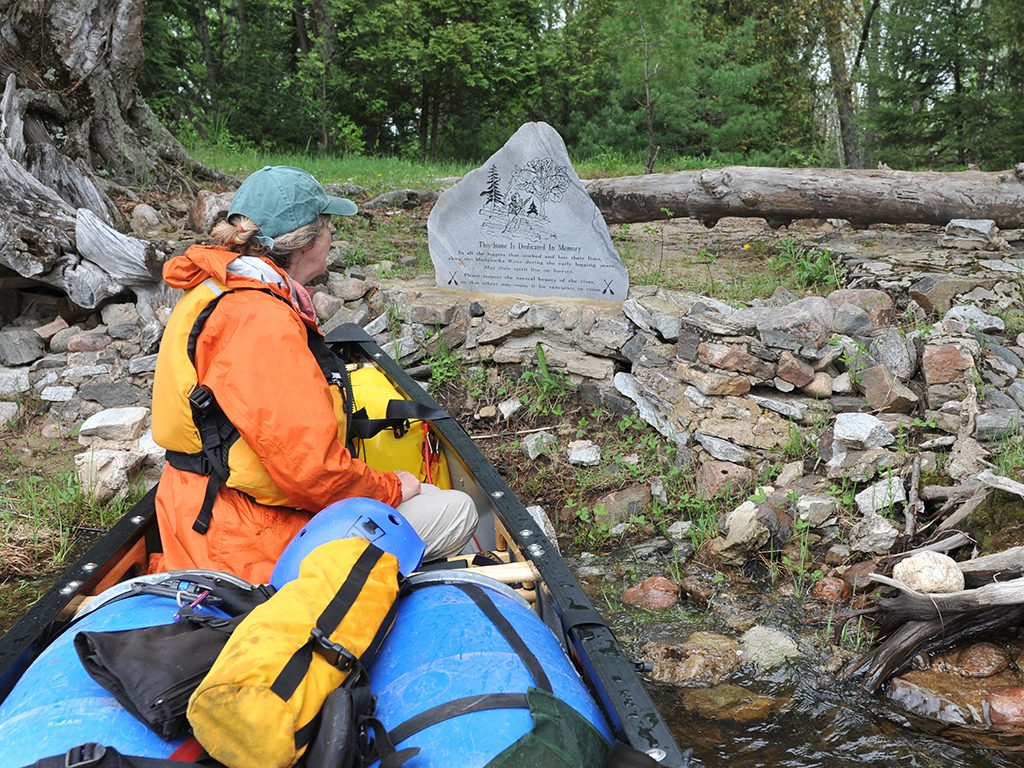
But the attraction of paddling the Madawaska doesn’t stop there. A public picnic area at the Griffith bridge makes for the perfect place to get canoes and equipment loaded for the ride home. And if you’re hungry, there’s a pizza parlour and patio right across the highway. Even better, outfitter Don Adams lives across the river from the picnic area where he rents canoes and equipment and offers a shuttle service.
The Madawaska serves up an easy way to go whitewater paddling in beautiful surroundings and that’s why it has brought me back time after time – so much that it helped me gain enough experience to finally try my hand at paddling Slate Falls several years ago, which I ran successfully, canoe full with water by the end and my heart pounding away in the stern. I still haven’t heard the screams of the loggers, though.
Story by Ralph Plath
Photos by Ralph Plath
Getting There and Back
Shuttle and Canoe Rentals
The Greater Madawaska Canoe Rentals and Shuttle Service:
– tel. – 613-333-2240
and ask for Don Adams
or Madawaska River Rentals:
– website – www.madriverrentals.ca
– tel. – 613 758 2165
